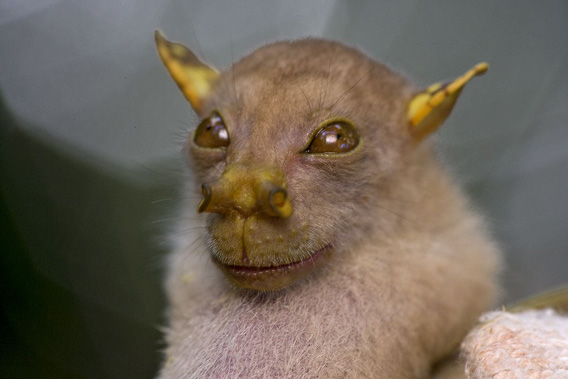
This fruit bat was first discovered in a remote tropical forest in Papua New Guinea. Although scientists have yet to name the species, the popular media has already dubbed it the ‘Yoda bat’ given its resemblance to the Jedi master character from the Star Wars series. Fruit bats are vital to rainforests as they disperse seeds. Photo © Piotr Naskrecki/iLCP.
Remote little-explored rainforests probably harbor the majority of undiscovered amphibians and land mammals according to a new study in Proceedings of the Royal Society B. The study calculated that it’s likely 33% of the world’s amphibians and 3% of terrestrial mammals still remain unknown. However, the paper also found that these undiscovered species are likely in worse peril of extinction than already-described species.
“We show that even after 250 years of taxonomic classification, about 3050 amphibian and at least 160 land mammal species remain to be discovered and described,” the researchers write. They did not calculate estimations for other taxa.
Estimates were arrived at by using a mathematical model, incorporating known amphibian and mammal species, the year in which species were discovered, and the region it inhabits.
Not surprisingly, new amphibians and land animals are most likely to be discovered in tropical rainforests, according to the paper. Regional hotspots for new species include the Neotropics, such as the Amazon and the Atlantic Forest; the African tropical regions like the Congo; and rainforests in Malaysia and Indonesia.
The more remote and untouched the forest the likelier it is that it harbors unknown species.
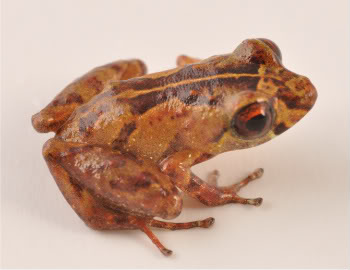 Discovered in 2008, this tiny frog is from the genus Pristimantis and is potentially new to science. It is one of the Andes’ smallest terrestrial vertebrates; the maximum body size for males is |
“The proportion of undescribed species increases with decreasing human footprint in tropical forest biomes,” the study explains. “This could be owing to the fact that tropical forests with low human footprint are less well-explored compared to areas with a higher level of human impact.”
However, authors also say that greater human impact may mean that a number of unknown species have already been pushed to extinction, making discovery impossible.
The paper also found that recently discovered species (such as one found in 2007 versus 1798) were more prone to be in danger of extinction, implying that undescribed species also have a higher chance of being globally imperiled.
“Many of the undescribed species in these two groups are likely in danger of extinction and could well disappear before they are discovered, especially given the high rates of habitat conversion in tropical forests,” the authors write, adding that “this is consistent with predictions that a large proportion of today’s undescribed species may go extinct without ever being recorded.”
The researchers conclude that “the perfect storm for biodiversity loss is upon us. Universities and funding agencies have weakened their support for taxonomic exploration and research, with little prospect of reversing this trend. Meanwhile, the very biomes that likely harbor the greatest number of undescribed species are being altered in ways that will drive many of these species to extinction.”
They recommend that efforts be made to rapidly place remote, unexplored areas in the tropics under protection in order to preserve the world’s ‘cryptic biodiversity’ for future discovery.
CITATION: Xingli Giam, Brett R. Scheffers, Navjot S. Sodhi, David S. Wilcove, Gerardo Ceballos, and Paul R. Ehrlich. Reservoirs of richness: least disturbed
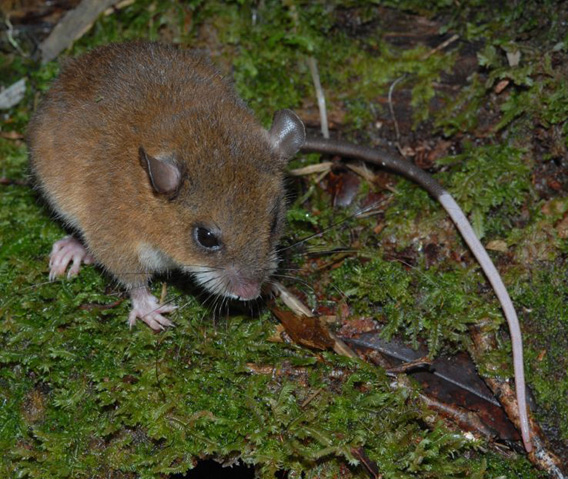
Discovered in a 2009 expedition in Papue New Guinea. Although this new mouse species resembles the prehensile-tailed tree mice of New Guinea, researchers believe this mountain mouse has no close relatives, representing a new genus. © CI/photo by Stephen Richards .
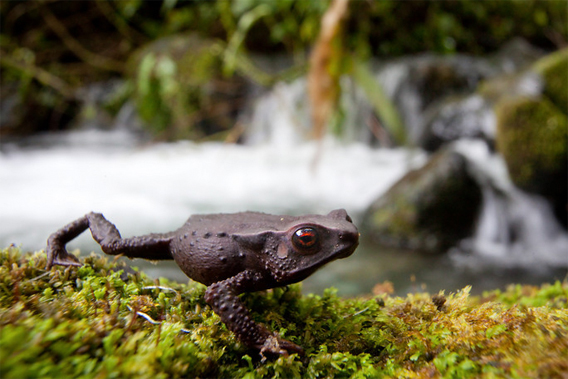
New toad species with striking red eyes found during the “Search for Lost Frogs” in the cloudforests of Chocó, Colombia. This highly unusual species has scientists baffled—they know nothing about this species other than where it lives. © Robin Moore/iLCP
Related articles
World’s sixth mass extinction still preventable
 (03/03/2011) So, here’s the good news: a mass extinction, the world’s sixth, is still preventable. But the bad news: if species currently threatened with extinction vanish—even over the next thousand years—homo-sapiens will be the first single species responsible for a mass extinction. Comparing today’s current extinction crisis with the big five that occurred in the past, a new study in Nature finds that while the situation is dire, the choice is ultimately up to humanity. “If you look only at the critically endangered mammals—those where the risk of extinction is at least 50 percent within three of their generations—and assume that their time will run out, and they will be extinct in 1,000 years, that puts us clearly outside any range of normal, and tells us that we are moving into the mass extinction realm,” explains lead author Anthony D. Barnosky, UC Berkeley professor of integrative biology.
(03/03/2011) So, here’s the good news: a mass extinction, the world’s sixth, is still preventable. But the bad news: if species currently threatened with extinction vanish—even over the next thousand years—homo-sapiens will be the first single species responsible for a mass extinction. Comparing today’s current extinction crisis with the big five that occurred in the past, a new study in Nature finds that while the situation is dire, the choice is ultimately up to humanity. “If you look only at the critically endangered mammals—those where the risk of extinction is at least 50 percent within three of their generations—and assume that their time will run out, and they will be extinct in 1,000 years, that puts us clearly outside any range of normal, and tells us that we are moving into the mass extinction realm,” explains lead author Anthony D. Barnosky, UC Berkeley professor of integrative biology.
Worldwide search for ‘lost frogs’ ends with 4% success, but some surprises
 (02/16/2011) Last August, a group of conservation agencies launched the Search for Lost Frogs, which employed 126 researchers to scour 21 countries for 100 amphibian species, some of which have not been seen for decades. After five months, expeditions found 4 amphibians out of the 100 targets, highlighting the likelihood that most of the remaining species are in fact extinct; however the global expedition also uncovered some happy surprises. Amphibians have been devastated over the last few decades; highly sensitive to environmental impacts, species have been hard hit by deforestation, habitat loss, pollution, agricultural chemicals, overexploitation for food, climate change, and a devastating fungal disease, chytridiomycosis. Researchers say that in the past 30 years, its likely 120 amphibians have been lost forever.
(02/16/2011) Last August, a group of conservation agencies launched the Search for Lost Frogs, which employed 126 researchers to scour 21 countries for 100 amphibian species, some of which have not been seen for decades. After five months, expeditions found 4 amphibians out of the 100 targets, highlighting the likelihood that most of the remaining species are in fact extinct; however the global expedition also uncovered some happy surprises. Amphibians have been devastated over the last few decades; highly sensitive to environmental impacts, species have been hard hit by deforestation, habitat loss, pollution, agricultural chemicals, overexploitation for food, climate change, and a devastating fungal disease, chytridiomycosis. Researchers say that in the past 30 years, its likely 120 amphibians have been lost forever.
From Cambodia to California: the world’s top 10 most threatened forests
 (02/02/2011) Growing populations, expanding agriculture, commodities such as palm oil and paper, logging, urban sprawl, mining, and other human impacts have pushed many of the world’s great forests to the brink. Yet scientists, environmentalists, and even some policymakers increasingly warn that forests are worth more standing than felled. They argue that by safeguarding vulnerable biodiversity, sequestering carbon, controlling erosion, and providing fresh water, forests provide services to humanity, not to mention the unquantifiable importance of having wild places in an increasingly human-modified world. Still, the decline of the world’s forests continues: the FAO estimating that around 10 million hectares of tropical forest are lost every year. Of course, some of these forests are more imperiled than others, and a new analysis by Conservation International (CI) has catalogued the world’s 10 most threatened forests.
(02/02/2011) Growing populations, expanding agriculture, commodities such as palm oil and paper, logging, urban sprawl, mining, and other human impacts have pushed many of the world’s great forests to the brink. Yet scientists, environmentalists, and even some policymakers increasingly warn that forests are worth more standing than felled. They argue that by safeguarding vulnerable biodiversity, sequestering carbon, controlling erosion, and providing fresh water, forests provide services to humanity, not to mention the unquantifiable importance of having wild places in an increasingly human-modified world. Still, the decline of the world’s forests continues: the FAO estimating that around 10 million hectares of tropical forest are lost every year. Of course, some of these forests are more imperiled than others, and a new analysis by Conservation International (CI) has catalogued the world’s 10 most threatened forests.
Study: REDD could save species from extinction, if well-funded
(12/01/2010) The burgeoning global program REDD+ (Reduced Emissions from Deforestation and Forest Degradation) could do more than mitigate climate change, according to a new study in Conservation Letters by scientists with Conservation International (CI). Analyzing a sample of 2,500 forest animals, including mammals, birds and amphibians, researchers found that REDD+ could reduce the rate of extinction among these species by 46-82% over five years. The wide range in the study’s findings depends on the amount of funds devoted to REDD+: more funds means greater forest preservation and, thereby, less extinction.
The march to extinction accelerates
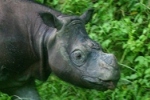 (10/26/2010) A fifth of the world’s vertebrate species (i.e. mammals, birds, reptiles, amphibians, and fish) are threatened with extinction, according to a massive new study by the International Union for the Conservation of Nature (IUCN); and the situation is worsening for the world’s wildlife: on average 52 species of mammals, birds, and amphibians move one category closer to extinction every year (the IUCN Red List categorizes species as Least Concern, Near Threatened, Vulnerable, Endangered, Critically Endangered, Extinct in the Wild, and then Extinct). However, the news isn’t all bad. The study found that conservation action does work: in the first analysis of its kind, researchers found that the global biodiversity decline would have been 18% worse if not for conservation attention, “nonetheless,” the authors—174 scientists from 38 countries—write, “current conservation efforts remain insufficient to offset the main drivers of biodiversity loss.” According to the study, these drivers include agricultural expansion, logging, over-exploitation of species, and invasive species.
(10/26/2010) A fifth of the world’s vertebrate species (i.e. mammals, birds, reptiles, amphibians, and fish) are threatened with extinction, according to a massive new study by the International Union for the Conservation of Nature (IUCN); and the situation is worsening for the world’s wildlife: on average 52 species of mammals, birds, and amphibians move one category closer to extinction every year (the IUCN Red List categorizes species as Least Concern, Near Threatened, Vulnerable, Endangered, Critically Endangered, Extinct in the Wild, and then Extinct). However, the news isn’t all bad. The study found that conservation action does work: in the first analysis of its kind, researchers found that the global biodiversity decline would have been 18% worse if not for conservation attention, “nonetheless,” the authors—174 scientists from 38 countries—write, “current conservation efforts remain insufficient to offset the main drivers of biodiversity loss.” According to the study, these drivers include agricultural expansion, logging, over-exploitation of species, and invasive species.
Mass extinction fears widen: 22 percent of world’s plants endangered
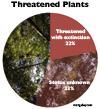 (09/28/2010) Scientific warnings that the world is in the midst of a mass extinction were bolstered today by the release of a new study that shows just over a fifth of the world’s known plants are threatened with extinction—levels comparable to the Earth’s mammals and greater than birds. Conducted by the Royal Botanic Gardens, Kew; the Natural History Museum, London; and the International Union for the Conservation of Nature (IUCN), the study is the first time researchers have outlined the full threat level to the world’s plant species. In order to estimate overall threat levels, researchers created a Sampled Red List Index for Plants, analyzing 7,000 representative species, including both common and rare plants.
(09/28/2010) Scientific warnings that the world is in the midst of a mass extinction were bolstered today by the release of a new study that shows just over a fifth of the world’s known plants are threatened with extinction—levels comparable to the Earth’s mammals and greater than birds. Conducted by the Royal Botanic Gardens, Kew; the Natural History Museum, London; and the International Union for the Conservation of Nature (IUCN), the study is the first time researchers have outlined the full threat level to the world’s plant species. In order to estimate overall threat levels, researchers created a Sampled Red List Index for Plants, analyzing 7,000 representative species, including both common and rare plants.
21% of Africa’s freshwater plants and animals threatened
(09/02/2010) 21 percent of African freshwater plant and animal species are threatened with extinction, according to a five year assessment of 5,167 freshwater species by 200 scientists.
30 frog species, including 5 unknown to science, killed off by amphibian plague in Panama
(07/19/2010) With advanced genetic techniques, researchers have drawn a picture of just how devastating the currently extinction crisis for the world’s amphibians has become in a new study published in the Proceedings of the Nation Academy of Sciences (PNAS). Studying frog populations using DNA barcoding in Panama’s Omar Torrijos National Park located in El Copé researchers found that 25 known species and 5 unknown species have vanished since 1998. None have returned.